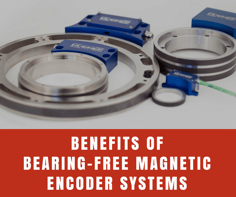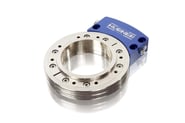 Magnetic encoder technology is vastly used in heavy industries such as steel mills, ship drives, gas turbines, power stations, drilling rigs, and so on. The rugged landscape and threat of harsh elements require delivery of control signals over a long period of time in a reliable and efficient manner. While optical scanning encoder systems are always an option, the extreme conditions make it unsuitable for installation. Extremely confined spaces, large shaft diameters and no free shafts are just some of the reasons as to why Magnetic Encoder technology needs to be adopted.
Magnetic encoder technology is vastly used in heavy industries such as steel mills, ship drives, gas turbines, power stations, drilling rigs, and so on. The rugged landscape and threat of harsh elements require delivery of control signals over a long period of time in a reliable and efficient manner. While optical scanning encoder systems are always an option, the extreme conditions make it unsuitable for installation. Extremely confined spaces, large shaft diameters and no free shafts are just some of the reasons as to why Magnetic Encoder technology needs to be adopted.
In light of the narrowing conditions, Johannes Huebner GmbH has designed new magnetic encoders. The new encoder systems are resistant to shocks and can cope with the continuous vibrations to transmit interference-free signals at all times. In retrospect, standard optical scanning systems require an extra layer of protection along with a bearing-supported shaft, which simply adds cost and complexity.
 The magnetic scanning principle in use by Johannes Huebner GmbH makes use of a stationary sensor that uses north-south poles to record changing magnetic fields. The alternating field produces a potential difference, either sinusoidal or rectangular. The principle eliminates any chances of soiling and holds in the face of large axial or radial distortions.
The magnetic scanning principle in use by Johannes Huebner GmbH makes use of a stationary sensor that uses north-south poles to record changing magnetic fields. The alternating field produces a potential difference, either sinusoidal or rectangular. The principle eliminates any chances of soiling and holds in the face of large axial or radial distortions.
The Magnetic encoder system holds the following four characteristics:
Safety
The robust mechanics make the system compatible with heavy duty fixing equipment, allowing the transfer of high-precision signals through multiple scanning. The magnetic encoders have gone through repeated speed and fatigue tests to make sure they are field-ready, and safe for operation.
Flexible
The magnetic encoder systems follow a modular concept that enables the company to come up with customized solutions according to customers’ problems in no time. The encoder can work with shaft diameters up to 1500mm, and can be installed with or without a free shaft. Extra-wide systems are available to accommodate the large axial shaft eccentricity while extra-slim systems are available for restricted spaces.
Reliable
As stated earlier, the magnetic encoder sports an extremely rugged design and can withstand harsh elements and external influences such as mechanical shocks, dust, vibration, liquids, etc. The electronics components are encapsulated in a heavy-duty housing while optional pulse wheel rings are attached to protect magnetic tracks.
Johannes Huebner GmbH does all the work for a client so that no room for errors is left behind. From taking on-site measurements to analyzing the installation position and assembling the complete magnetic encoder system, Huebner takes care of it all.
Applications & Use
The steel industry is one such establishment that requires a certain degree of automation to function properly and stay afloat. With continuously improving manufacturing methods and better material techniques available, there is a very narrow range of tolerance for errors throughout the entire process. The requirements put forward by the industry range from sophisticated sensor technology for specialized steelmaking to price-sensitive solutions for large-scale deployment.
Once again, harsh conditions prove to be a major threat for magnetic encoders in the steel and metal industry. However, Johannes Huebner GmbH’s bearing-less magnetic encoder systems can cope with all such issues. All systems are designed as accurately as possible according to the client’s system. This leaves little room for errors to accumulate. In addition, the robust construction and rigorous testing makes sure that none of the signals get distorted at any instance. As a result, a worthy investment pays itself off providing a competitive edge in the market and a highly profitable and available system as a whole.
Interested in learning more about Huebner Giessen Magnetic Encoder Systems?
You May Also Be Interested in Reading:


